《汽车专业英语读译教程》--20-U11TC
- 格式:ppt
- 大小:747.50 KB
- 文档页数:24
![汽车专业英语(第二版)[111页]](https://img.taocdn.com/s1/m/79b645a1ed630b1c59eeb5ef.png)

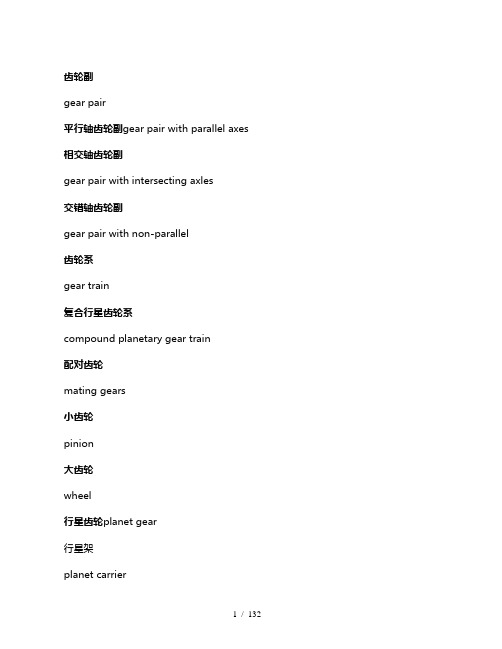
齿轮副gear pair平行轴齿轮副gear pair with parallel axes 相交轴齿轮副gear pair with intersecting axles交错轴齿轮副gear pair with non-parallel齿轮系gear train复合行星齿轮系compound planetary gear train配对齿轮mating gears小齿轮pinion大齿轮wheel行星齿轮planet gear行星架planet carrier太阳轮sun gear内齿圈ring gear外齿轮external gear内齿轮internal gear减速齿轮副speed reducing gear pair 增速齿轮副speed increasing gear train 中心距centre distance轴交角shaft angle连心线line of centres齿数比gear ratio传动比transmission ratio 减速比speed reducing ratio 参考平面reference planes轴平面axial plane基准平面datum plane节平面pitch plane端平面transverse plane法平面normal plane遐想曲面imaginary srufaces 分度曲面reference surface节曲面pitch surface齿顶曲面tip surface齿根曲面root surface基本齿廓basic rack tooth profile 产形齿条counterpart rack基准线datum line轮齿特性teeth characteristics 轮齿gear齿槽tooth space右旋齿right-hand teeth左旋齿left-hand teeth齿面tooth flank右侧齿面right flank左侧齿面left flank同侧齿面corresponding flanks 异侧齿面opposite flanks工作齿面working flank非工作齿面non-working flank 相齿齿面mating flank可用齿面rsable flank有效齿面active flank上齿面addendum flank 下齿面dedendum flank 齿根过渡曲面fillet齿顶面crest top land齿槽底面〔槽底〕bottom land齿廓tooth profile端面齿廓transverse profile 法向齿廓normal profile轴向齿廓axial profile齿线tooth trace齿棱tip surface模数module端面模数transverse module法面模数normal module轴向模数axial module径节diametral pitch当量齿数virtual number of teeth 头数number of threads螺旋线helix and spirals圆锥螺旋线conical spiral螺旋角helix angle导程lead导程角lead angle摆线trochoids外摆线eqicycloid圆心渐开线involute to a circle 延伸渐开线prolate involute 螺旋面helicoid干涉interference修形correction of the flank shape 修像tip relief修根root relief齿面修形axial modification齿端修薄end relief鼓形修整crowning挖根undercut瞬时轴instantaneous axis啮合engagement mesh端面啮合线transverse path of contact啮合齿面surface of action啮合平面plane of action重合度contact ratio and overlap ratio 总作用弧total arc of transmission纵向作用弧overlap arc总作用角total angle of transmission径向变位系数overlap arc圆程齿轮和圆柱齿轮副ckyclindrical gears and gear pairs 齿条rack直齿轮spur gear斜齿轮helical gear直齿条spur rack大字齿轮double-helical gear渐开线齿轮involute cylindrical gear 圆弧圆柱齿轮circular -arc gear分度圆柱面reference cylinder节圆柱面pitch cylinder基圆柱面base cylinder齿顶圆柱面tip cylinder齿根圆柱面root cylinder节点pitch point分度圆pitch line节圆pitch circle基圆base circle齿顶圆〔顶圆〕tip circle齿根圆〔根圆〕root circle法向螺旋线normal helix齿距pitch齿距角angular pitch公法线总长base tangent length分度圆直径reference diameter 齿高tooth depth齿宽face width齿顶高dedendum齿根高dedendum弦齿高chordal height固定弦齿高constant cord height 齿厚tooth thickness惊险电影thriller movie电影院常客cinemogoer以惊险的谋杀疑案为主线thriller nuder mystery at its heart 顶隙bottom clearance圆周侧隙circumferential backlash法向侧隙normal backlash径向侧隙radial backlash锥齿轮bevel gear锥齿轮副bevel gear pair准双曲面齿轮副hypoid gear pair冠轮crown gear端面齿盘contrate gear直齿锥齿轮straight bevel gear斜齿锥齿轮helical bevel gear曲线齿锥齿轮spiral bevel gear弧齿锥齿轮gleason spiral bevel gear 摆线齿锥齿轮overlikon spiral bevel gear 零度锥齿轮zerol bevel gear分度圆锥面reference cone分度圆reference circle分锥顶点reference cone apex外锥距outer cone distance分度圆直径reference diameter齿高tooth depth齿顶高addendum齿根高dedendum工作高度working depth弦齿高chordal height齿距pitch齿距pitch齿厚tooth thickness弦齿厚chordal tooth thickness齿槽宽space width齿宽face width安装距locating distance轮冠距tip distance冠顶距apex to crown顶隙bottom clearance分度圆锥角reference cone angle 齿顶角addendum angle齿根角dedendum angle压力角pressure angle齿厚半角tooth thickness half angle槽宽半角apace width half angle轮椅升降机Wheel chair lift图例legend工位station吊运装置overhead hoist更衣室restroom1号厂房工艺布置方案图proposal of the Plant I layout 合笼mate底盘平移台chassis shuttle车辆转移台bus transfer前围角板front wall angle cover后围侧板rear wall side cover保险杠bumper三类底盘three type chassis左侧围应力蒙皮R/S stretching skin <road side>中涂floating coat拼装台collector切割轮口wheel -arch cutting内饰trim线束harness返工re-doing轮罩护板wheel house发车前准备pre-delivery举升hoist小批量产品be pilot2 套two kits配电站power transformer substation裙板skirt发动机托架engine holding frame诊断报警系统diagnosis and alarming system 互换性interchangeability缩微图纸microfiche files总装final assembly磷化phosphating仪表板dash board切齐trimming结构完整性structure integrity自动愈合的防腐材料self-healing corrosion preventative material 长途客车inter-city bus改装厂refitting factory遮阳板sun visor随车工具tool box钢化玻璃toughened grass异形钢管special steel pipe全天候空调系统full range A/C强制通风ram-air ventilation停机时间downtime无公害柴油clean diesel宽敞悬臂式座椅roomy cantilevered seat防滑地板no-skid floor织物纹里铝合金textured aluminum extrution爬坡能力grade ability排水阀drain valve除湿器moisture ejector怠速时at idle琴式驱动桥banjo type drive axle通风口duct恒温控制thermostatic control平衡水箱surge tank变光开关simmer switch消音器muffler防破坏vandal resistant聚碳化透镜poly-carbonate len镀锌板galvanized plate搭接lap亮丽的外表smart apperance隐藏式固定concealed fastening水洼ponding发动机中置式客车bus with under floor engine 组合式客车车身modular bus body薄壳式结构shell construction衬垫pad空气导流板air deflector搁梁shelf beam腰梁waist rail梭梁stabilizing beam腰带式安全带diagonal safety belt压条trim strip嵌条insertion strip翼板fender斜撑bracing piece转向盘回正性试验test of steering wheel returnability转向盘转角脉冲试验steering wheel impulse input test转向盘转角阶跃输入试验steering wheel step input or transient state yaw response test极限侧向加速度试验limiting lateral acceleration test汽车平顺性随机输入行驶试验automobile ride random input running test汽车平顺性单脉冲输入行驶试验automobile ride single pulse input running test 汽车悬挂系统固有频率与阻尼比的测定试验measurement of natural frequency and damping raito of suspension功率突然变化影响试验test of effect of sudden power change收油门后控制试验test of control at breakway横风稳定性试验test of crosswind stability反冲试验kick-back test轮胎爆破响应时间试验test of burst response of tyre绕过障碍物试验obstacle avoidance test移线试验lane change testJ型转弯试验test of J turn频率响应时间试验frequency response test瞬态响应时间试验transient response test阶路响应时间试验step response test脉冲响应试验pulse response test静态操舵力试验static steering effort test悬架举升试验jack-up test of suspension耐翻倾试验test of overturning immunity轮辋错动试验rim slip test风洞试验wind tunnel test制动稳定性试验test of braking stability最小转弯直径试验minimum turning diameter test 操舵力试验steering effort test汽车发动机类型type发动机engine内燃机intenal combusiton engine动力机装置power unit汽油机gasoline engine汽油喷射式汽油机gasoline-injection engine火花点火式发动机spark ignition engine压燃式发动机compression ignition engine往复式内燃机reciprocating internal combustion engine 化油器式发动机carburetor engine柴油机diesel engine转子发动机rotary engine旋轮线转子发动机rotary trochoidal engine二冲程发动机two-stroke engine四冲程发动机four-stroke engine直接喷射式柴油机direct injection engine间接喷射式柴油机indirect injection engine增压式发动机supercharged engine风冷式发动机air-cooled engine油冷式发动机oil-cooled engine水冷式发动机water-cooled engine自然进气式发动机naturally aspirated engine煤气机gas engine液化石油气发动机liquified petroleum gas engine柴油煤气机diesel gas engine多种燃料发动机multifuel engine石油发动机hydrocarbon engine双燃料发动机duel fuel engine热球式发动机hot bulb engine多气缸发动机multiple cylinder engine 对置活塞发动机opposed piston engine 对置气缸式发动机opposed-cylinder engine 十字头型发动机cross head engine直列式发动机in-line engine星型发动机radial engine筒状活塞发动机trunk-piston engine斯特林发动机stirling engine套阀式发动机knight engine气孔扫气式发动机port-scavenged engine 倾斜式发动机slant engine前置式发动机front-engine后置式发动机rear-engine中置式发动机central engine左侧发动机left-hand engine右侧发动机right-hand engine短冲程发动机oversquare engine长冲程发动机undersquare engine等径程发动机square engine顶置凸轮轴发动机overhead camshaft engine双顶置凸轮轴发动机dual overhead camshaft engine V形发动机V-engine顶置气门发动机valve in-head engine侧置气门发动机side valve engine无气门发动机valveless engine多气门发动机multi-valve engine 卧式发动机horizontal engine 斜置式发动机inclined engine立式发动机vertical engineW形发动机w-engineI形发动机I-engineL形发动机L-engineF形发动机F-engine性能performance二冲程循环two-stroke cycle四冲程循环four-stroke cycle狄塞尔循环diesel cycle奥托循环otto cycle混合循环mixed cycle定容循环constant volume cycle 工作循环working cycle等压循环constant pressure cycle 理想循环ideal cycle热力循环thermodynamic cycle 冲程stroke活塞行程piston stroke长行程long stroke上行程up stroke下行程down stroke进气行程intake stroke充气行程charging stroke压缩行程compression stroke 爆炸行程explosion stroke膨胀行程expansion stroke 动力行程power stroke排气行程exhaust stroke膨胀换气行程expansion-exchange stroke换气压缩行程exchange-compression stroke止点dead center上止点top dead center<upper dead center>下止点lower dead center<bottom dead center> 上止点前budc<before upper dead center>上止点后atdc<after top dead cetner>下止点前bbdc<before bottom dead center>下止点后abdc<after bottom dead center>缸径cylinder bore缸径与行程bore and stroke空气室energy chamber气缸余隙容积cylinder clearance volume燃烧室容积combustion chamber volume 气缸最大容积maximum cylinder volume 压缩室compression chamber排气量displacement发动机排量engine displacement活塞排量piston swept volume气缸容量cylinder capacity单室容量single-chamber capacity 容积法volumetry压缩比compression ratio临界压缩比critical compression ratio 膨胀比expansion ratio面容比surface to volume ratio 行程缸径比stroke-bore ratio混合比mixture ratio压缩压力compression pressure制动平均有效压力brake mean effective pressure<bmep> 空燃比air fuel ratio燃空比fuel air ratio燃料当量比fuel equivalence ratio扭矩torque单缸功率power per cylinder升功率power per liter升扭矩torque per liter升质量mass per liter减额功率derating power输出马力shaft horsepower马力小时,马力时horsepower-hour总马力gross horse power总功率gross power净功率net power燃油消耗量fuel consumption比燃料消耗率specific fuel consumption 空气消耗率air consumption机油消耗量oil consumption有效马力net horse power额定马力rated horse power马力重量系数horsepower-weight factor 制动功率brake horse power制动热效率brake thermal efficiency总效率overall efficiency排烟极限功率smoke limiting horsepower 功率曲线power curve机械损失mechanical loss机械效率mechanical efficiency有效热效率effective thermal efficiency充气系数volumetric efficiency过量空气系数coefficient of excess air适应性系数adaptive coefficient扭矩适应性系数coefficient of torque adaptibility 转速适应性系数speed adaptive coefficient强化系数coefficient of intensification校正系数correction factor换算系数conversion factor活塞平均速度mean piston speed发动机转速engine speed <rotational frequency> 怠速转速idling speed经济转速economic speed起动转速starting speed最低稳定工作转速lowest continuous speed with load 最大扭矩转速speed at maximum torque最高空转转速maximum no load governed speed 调速speed governing超速overspeed怠速idling转速波动率speed fluctuation rate工况working condition<operating mode> 额定工况declared working condition变工况variable working condition稳定工况steady working condition空载no-load全负荷full load超负荷overload部分负荷part load充量〔进气〕charge旋转方向direction of rotation 顺时针clockwise逆时针counter-clockwise 左转left-hand rotation 右转right-hand rotation 外径major diameter中径pitch diameter内径minor diameter径向间隙radial clearance发动机性能engine performance 加载性能loading performance起动性能starting performance加速性能acceleration performance动力性能power performance排放性能emission performance空转特性no load characteristics负荷特性part throttle characteristics调速特性governor control characteristics 万有特性mapping characteristics稳定调速率steady state speed governing rate 气缸体和气缸盖cylinder block and head气缸体cylinder block整体铸造cast inblock <cast enblock> 发动机罩engine bonnet气缸体加强筋engine block stiffening rib 气缸cylinder〔转子机〕缸体stator缸径cylinder bore气缸体机架cylinder block frame气缸盖cylinder head配气机构箱valve mechanism casing气缸体隔片cylinder spacer气缸盖密封环cylinder head ring gasket气缸盖垫片cylinder head gasket气缸套cylinder liner<cylinder sleeve> 干式缸套dry cylinder liner湿式缸套wet cylinder liner气缸水套water jacket膨胀塞expansion plug防冻塞freeze plug气缸壁cylinder wall环脊ring ridge排气口exhaust port中间隔板intermediate bottum导板guideway创成半径〔转子机〕generating radius缸体宽度〔转子机〕operating width机柱column燃烧室combustion chamber主燃烧室main combustion chamber 副燃烧室subsidiary combustion chamber预燃室prechamber涡流燃烧室`swirl combustion chamber分开式燃烧室divided combustion chamber涡流式燃烧室turbulence combustion chamber半球形燃烧室hemispherical combustion chamber 浴盆形燃烧室bathtub section combustion chamber L形燃烧室L-combustion chamber楔形燃烧室wedge-section combustion chamber 开式燃烧室open combustion chamber封闭喷射室closed spray chamber活塞顶内燃烧室piston chamber爆发室explosion chamber燃烧室容积比volume ratio of combustion cahmber燃烧室口径比surface-volume ratio of combustion chamber 通道面积比area ratio of combustion chamber passage 曲轴箱通气口crankcase breather凸轮轴轴承座camshaft bearing bush seat定时齿轮室罩camshaft drive<gear>cover曲轴箱检查孔盖crankcase door曲轴箱防爆门crankcase explosion proof door 主轴承盖main bearing cap气缸盖罩valve mechanism cover飞轮壳flywheel cover扫气储器scavenging air receiver活塞piston裙部开槽活塞split skirt pistonU形槽活塞U-slot piston滚花修复活塞knurled piston圆顶活塞dome head piston平顶活塞flat head piston凸顶活塞crown head piston<convex head piston> 凹顶活塞concave head piston阶梯顶活塞step-head piston筒形活塞trunk piston椭圆形活塞oval piston抗热变形活塞autothermic piston不变间隙活塞constant clearance piston镶因瓦钢片活塞invar strut piston直接冷却式活塞direct-cooled piston间接冷却式活塞indirect cooled piston 滑裙活塞slipper piston活塞速度piston speed活塞顶部piston head活塞裙部piston skirt整体活塞裙solid skirt活塞裙扩大衬簧piston skirt expander 滑履式活塞裙slipper skirt隔热槽heat dam活塞标记piston mark活塞销。
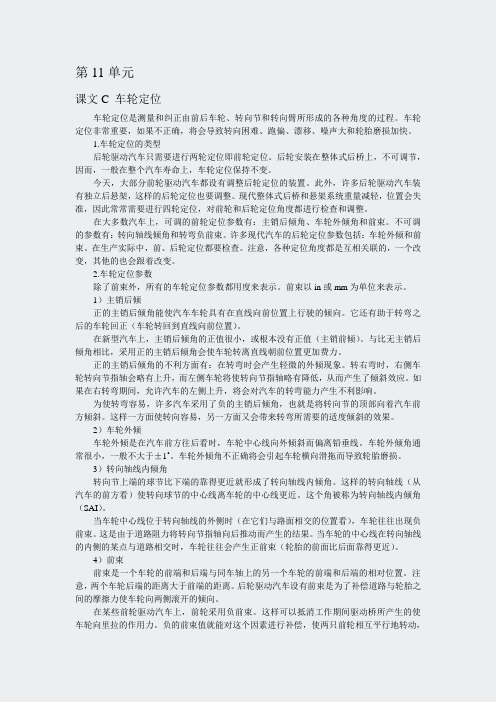
第11单元课文C 车轮定位车轮定位是测量和纠正由前后车轮、转向节和转向臂所形成的各种角度的过程。
车轮定位非常重要,如果不正确,将会导致转向困难、跑偏、漂移、噪声大和轮胎磨损加快。
1.车轮定位的类型后轮驱动汽车只需要进行两轮定位即前轮定位。
后轮安装在整体式后桥上,不可调节,因而,一般在整个汽车寿命上,车轮定位保持不变。
今天,大部分前轮驱动汽车都设有调整后轮定位的装置。
此外,许多后轮驱动汽车装有独立后悬架,这样的后轮定位也要调整。
现代整体式后桥和悬架系统重量减轻,位置会失准,因此常常需要进行四轮定位,对前轮和后轮定位角度都进行检查和调整。
在大多数汽车上,可调的前轮定位参数有:主销后倾角、车轮外倾角和前束。
不可调的参数有:转向轴线倾角和转弯负前束。
许多现代汽车的后轮定位参数包括:车轮外倾和前束。
在生产实际中,前、后轮定位都要检查。
注意,各种定位角度都是互相关联的,一个改变,其他的也会跟着改变。
2.车轮定位参数除了前束外,所有的车轮定位参数都用度来表示。
前束以in或mm为单位来表示。
1)主销后倾正的主销后倾角能使汽车车轮具有在直线向前位置上行驶的倾向。
它还有助于转弯之后的车轮回正(车轮转回到直线向前位置)。
在新型汽车上,主销后倾角的正值很小,或根本没有正值(主销前倾)。
与比无主销后倾角相比,采用正的主销后倾角会使车轮转离直线朝前位置更加费力。
正的主销后倾角的不利方面有:在转弯时会产生轻微的外倾现象。
转右弯时,右侧车轮转向节指轴会略有上升,而左侧车轮将使转向节指轴略有降低,从而产生了倾斜效应。
如果在右转弯期间,允许汽车的左侧上升,将会对汽车的转弯能力产生不利影响。
为使转弯容易,许多汽车采用了负的主销后倾角,也就是将转向节的顶部向着汽车前方倾斜。
这样一方面使转向容易,另一方面又会带来转弯所需要的适度倾斜的效果。
2)车轮外倾车轮外倾是在汽车前方往后看时,车轮中心线向外倾斜而偏离铅垂线。
车轮外倾角通常很小,一般不大于±1˚。

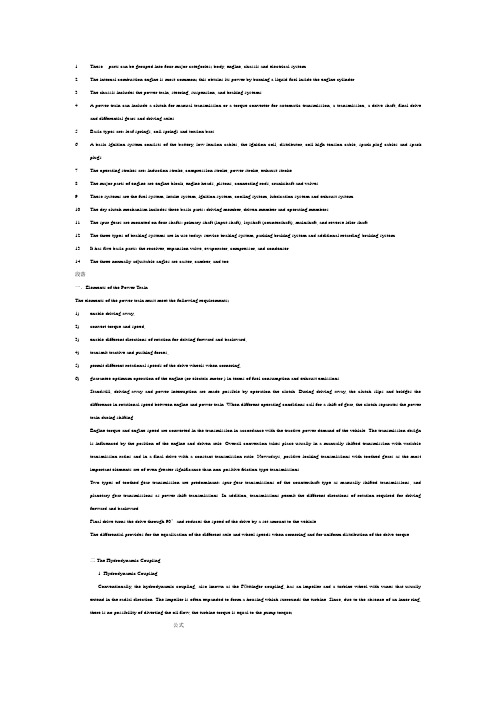
1.These parts can be grouped into four major categories; body, engine, chassis and electrical system.2.The internal combustion engine is most common; this obtains its power by burning a liquid fuel inside the engine cylinder.3.The chassis includes the power train, steering, suspension, and braking systems.4. A power train can include a clutch for manual transmission or a torque converter for automatic transmission, a transmission, a drive shaft, final driveand differential gears and driving axles.5.Basic types are: leaf springs, coil springs and torsion bars.6. A basic ignition system consists of the battery, low-lension cables, the ignition coil, distributor, coil high-tension cable, spark plug cables and sparkplugs.7.The operating strokes are: induction stroke, compression stroke, power stroke, exhaust stroke.8.The major parts of engine are engine block, engine heads, pistons, connecting rods, crankshaft and valves.9.These systems are the fuel system, intake system, ignition system, cooling system, lubrication system and exhaust system.10.The dry clutch mechanism includes three basic parts: driving member, driven member and operating members.11.The spur gears are mounted on four shafts: primary shaft (input shaft), layshaft (countershaft), mainshaft, and reverse idler shaft.12.The three types of braking systems are in use today: service braking system, parking braking system and additional retarding-braking system.13.It has five basic parts: the receiver, expansion valve, evaporator, compressor, and condenser.14.The three normally adjustable angles are caster, camber, and toe.段落一.Elements of the Power TrainThe elements of the power train must meet the following requirements;1)enable driving away,2)convert torque and speed,3)enable different directions of rotation for driving forward and backward,4)transmit tractive and pushing forces,5)permit different rotational speeds of the drive wheels when cornering,6)guarantee optimum operation of the engine (or electric motor ) in terms of fuel consumption and exhaust emissions.Standstill, driving-away and power interruption are made possible by operation the clutch .During driving away, the clutch slips and bridges the difference in rotational speed between engine and power train. When different operating conditions call for a shift of gear, the clutch separates the power train during shifting.Engine torque and engine speed are converted in the transmission in accordance with the tractive-power demand of the vehicle. The transmission design is influenced by the position of the engine and driven axle. Overall conversion takes place usually in a manually shifted transmission with variable transmission ratios and in a final drive with a constant transmission ratio. Nowadays, positive-locking transmissions with toothed gears as the most important elements are of even greater significance than non-positive friction-type transmissions.Two types of toothed-gear transmission are predominant: spur-gear transmissions of the countershaft type as manually shifted transmissions, and planetary-gear transmissions as power-shift transmissions. In addition, transmissions permit the different directions of rotation required for driving forward and backward.Final drive turns the drive through 90°and reduces the speed of the drive by a set amount to the vehicle.The differential provides for the equalization of the different axle and wheel speeds when cornering and for uniform distribution of the drive torque.二.The Hydrodynamic Coupling1. Hydrodynamic CouplingConventionally, the hydrodynamic coupling, also known as the Fötttinger coupling, has an impeller and a turbine wheel with vanes that usually extend in the radial direction. The impeller is often expanded to form a housing which surrounds the turbine. Since, due to the absence of an inner ring, there is no possibility of diverting the oil flow, the turbine torque is equal to the pump torque;公式Therefore 公式The index number depends on the design, the vane angle and the degree of filling of the coupling. The main working area of an hydrodynamic coupling is at v=0.9.2. Hydrodynamic ConverterThe hydrodynamic converter, also known as the Trilok or Fötttinger converter, is capable of operating in two phases: with torque increase in the first phase, and as a hydrodynamic coupling in the second phase. The usual design has three impellers:1) The pump, which is connected to the engine, acts like a centrifugal pump to produce the flow energy of a fluid.2) The turbine, which is connected to the transmission input, converts the flow energy back into mechanical energy.3) The reactor between turbine and pump diverts the flow of the fluid.Thus, the torque output is higher than the pump torque input from the engine. The torque increaseμμ=Mt/Mp is all the higher, the greater the speed difference (slip)between the pump and turbine. Withυ=0, i.e. with the turbine braked to a standstill (stall point, drive-away point), torque conversion reaches its maximum value and falls virtually linearly with rising turbine speed to a torque ratio of 1:1 at the coupling point. Above the coupling point, the reactor, which is supported on the housing by a one-way clutch, runs, torque-free, in the flow. Thus, the converter is now a clutch without torque conversion.For automobiles, the vane geometries are such that, at the drive-away point, the maximum torque increase μA is between 2 and 2.5. The hydraulic efficiencyηhydr=υμis similar in the conversion range to the speed ratioμand reaches values around 97% at high speed.Fluid couplings form the input element of automatic transmissions (in conjunction with planetary-gear trains, clutches, brakes and one-way clutches) and also of manually shifted transmissions in the form converter and clutch unit.三.Constant-mesh TransmissionFig.3-6 illustrates the flow of torque through a typical constant-mesh transmission. This type uses helical or double helical gears which are always in mesh. The mainshaft gear wheels are mounted on bearings and when a gear is required the mainshaft gear is locked to the shaft by a dog clutch.Although the mechanical efficiency is lower the helical gears are quieter and any damage resulting from a bad gear change occurs to the dog teeth instead of the actual gear teeth.元素的力量训练动力传动的要素必须符合下列要求;1)使开车逃走,2)把转矩和速度,3)使不同方向的旋转带动向前和向后,四)推进传送叶轮力量,5)允许不同转速时的驱动轮转弯时,六)保证了优化运行的引擎(或电机)从油耗和尾气排放。

专业英语一automobile 汽车〔美〕assembly line 装配线petroleum refining石油提炼body and frame 车身与车架engine发动机、引擎drive line 传动系统running gear 控制装置suspension 悬架系统unitized body 承载式车身gasoline engine 汽油机diesel engine 柴油机gas turbine 燃气轮机battery 电池〔组〕fuel cell 燃料电池hybrid power混合动力系统piston 活塞rotary engine 转子发动机vehicle 车辆transmission 变速器drive shaft 传动轴differential 差速器rear axle 后轴rear-wheel drive 后轮驱动front-wheel drive 前轮驱动braking system 制动系统wheel 车轮tire 轮胎steering system 转向系统spring 弹簧shock absorber 减震器Macpherson strut 麦弗逊式悬架torsion bar 扭力杆strut rod 支撑杆stabilizer bar 横向稳定杆二internal combustion engine 内燃机external combustion engine 外燃机fuel 燃料steam engine 蒸汽机intermittent combustionengine 间隔燃烧式发动机continuous combustionengine 连续燃烧式发动机turbine engine 涡轮发动机rocket engine 火箭发动机jet engine 火箭发动机Wankel engine 汪克尔发动机、转子发动机stroke 行程cooling system 冷却系统fuel system 燃料系统ignition system 点火系统spark-ignition engine 火花点燃式发动机compression-ignition engine压燃式发动机liquid-cooled 水冷式〔液体冷却〕air-cooled 风冷式〔空气冷却〕三cylinder block 缸体cylinder 气缸connecting rod 连杆crankshaft 曲轴cylinder head 气缸盖combustion chamber燃烧室valve 气门、阀camshaft 凸轮轴flywheel 飞轮intake manifold 进气歧管exhaust manifold 排气歧管carburetor 化油器fuel injector 燃料喷射器cast iron 铸铁aluminum 铝cooling fluid 冷却液spark plug 火花塞intake valve 排气门cam 凸轮gear 齿轮belt 皮带chain 链条overhead camshaft〔OHC〕上置式凸轮轴rpm=revolutions per minute转速、转数每分钟horsepower 马力intake system 进气系统sensor 传感器oxygen sensor 氧传感器fuel induction燃料吸入系统四fuel tank 油箱fuel line 燃料管路fuel pump 燃料泵fuel filter燃料滤清器power train control module〔PCM〕动力系统控制模块fuel injection system 燃料喷射系统distributor 分电器ignition coil 点火线圈ignition wire 点火线路charging system 充电系统ignition switch 点火开关solenoid 电磁线圈starter motor 起动电机alternator 交流发电机voltage regulator 稳压器lubrication system润滑系统oil pump 机油泵oil filter 机油滤清器oil cooler 机油冷却器antifreeze 防冻液coolant pump 冷却液泵thermostat 节温器radiator 散热器、水箱clutch 离合器radiator overflow tank 散热器溢流箱、膨胀水箱air intake ducting 进气管air filter 空气滤清器manifold air pressure sensor 进气歧管压力传感器turbocharger 涡轮增压器muffler 消声器、消音器catalytic converter 催化转化器exhaust pipe 排气管pollution control system 排放控制系统carbon monoxide 一氧化碳nitrogen oxide 氮氧化物hydrocarbons 碳氢化合物carbon canister 碳罐exhaust gas recirculator 〔EGR〕废气再循环positive crankcase ventilation 强制曲轴箱通风diverter valve 分流阀vapor-liquid separator 气液别离器vacuum modulator 真空调节器五timing 正时、定时air-fuel ratio 空燃比stoichiometric ratio 理论空燃比mixture 混合气top dead center〔TDC〕上止点bottom dead center〔BDC〕下止点bore 气缸直径、孔径crankpin 连杆轴颈、曲柄销throw 曲柄半径displacement 排量compression ratio 压缩比four-stroke engine 四冲程发动机intake stroke 进气冲程compression stroke 压缩冲程power stroke 做功行程exhaust stroke 排气行程preignition 提前点火valve overlap 气门重叠六two-stroke engine 二冲程发动机truck 货车、卡车bus 公共汽车Mercedes-Benz 梅赛德斯奔驰pickup truck 皮卡camper 露营车travel trailer 旅行拖车high-pressure injection 高压喷射low-pressure injection低压喷射injector 喷油器、喷嘴psi 磅/平方英寸〔英制压强单位〕photochemical smog 光化学烟雾outboard motor 舷外发动机snowmobile 摩托雪橇chain saw 链锯、电锯reed valve 簧片阀lubricant 润滑剂、润滑油scavenging 扫气General Motors 通用汽车blower 扫气泵rotor 转子coal-fired 燃煤的、烧煤的nuclear-powered 核动力的drivability 动力性、驱动性能generator 发电机transaxle 变速差速器、联合传动器electronic controller 电子控制器downshift 降档manual transmission 手动变速器hydrogen 氢carbon dioxide 二氧化碳oxygen 氧methanol 甲醇spacecraft 航天器、宇宙飞船anode 正极、阳极cathode 阴极、负极七oil pan 油底壳、机油盘water jacket 水套cylinder sleeve 气缸套dry sleeve 干缸套wet sleeve 湿缸套warpage 变形liner 衬套、衬垫bearing 轴承harmonic balancer vibrationdamper 扭转减震器timing gear 正时齿轮connecting rod journal 连杆轴颈main(bearing)journal主轴颈counterweight 平衡重thrust surface 推力面drive flange 传动法兰盘、凸缘fillet 圆角nose 〔曲轴〕前端pulley 皮带轮air conditioning 空调bearing cap 轴承盖copper 铜lead 铅Babbitt 巴氏合金tin 锡bearing clearance 轴承间隙thrust bearing 推力轴承、止推轴承thrust washer 推力垫圈、止推垫圈piston ring 活塞环compression ring 气环oil control ring 油环piston pin 活塞销lock ring 锁环piston land 活塞顶部heat dam 绝热槽piston head 活塞头部piston skirt 活塞裙部ring groove 活塞环槽piston pin bushing 活塞销衬套ring end gap 活塞销开口间隙ductile iron 球墨铸铁chromium 铬molybdenum 钼torsional ring 扭曲环chrome-plated 镀铬的rod cap 连杆盖bearing insert 轴承衬套八cross-flow head 横流式气缸盖coolant 冷却液head gasket 气缸垫wedge-shaped combustion chamber 楔形燃烧室hemispherical combustion chamber 半球形燃烧室open combustion chamber 开式燃烧室、统一式燃烧室pre-combustion chamber 预燃式燃烧室valve seat 气门座valve guide 气门导管retainer 弹簧座valve spring 气门弹簧high-chrome steel 高铬钢stellite 钴铬钨硬质合金keeper 锁紧装置valve stem 气门杆lifter 挺柱pushrod 推杆rocker arm 摇臂valve train clearance 气门间隙variable valve timing 可变气门正时九oil pressure regulator 机油压力调节器main oil gallery 主油道oil screen 机油滤网oil pressure sensor 机油压力传感器dashboard 仪表板sump 机油箱、油底壳baffle 挡板gear-type oil pump齿轮油泵rotor oil pump 转子油泵pressure regulator valve 调压阀十water pump 冷却水泵pressure cap 压力水箱盖fan 冷却风扇temperature indicator 温度指示器air-cooled system 风冷系统liquid-cooled system 水冷系统transmission cooler 自动变速箱油冷却器expansion tank 膨胀水箱housing 外壳impeller 叶轮、转子hub 轮毂pulley 皮带轮closed cooling system 闭式冷却系统十一electronic carburetor 电控化油器fuel vapor line 燃油蒸汽管fuel injector pump 喷油泵nozzle 喷嘴、管嘴plastic 塑料fuel cap 油箱盖filler neck 油箱填充口颈fuel metering unit 油量计量装置mechanical fuel pump 机械燃油泵electrical fuel pump 电动燃油泵fuel pressure regulator 燃油压力调节器injector fuel rail 燃油分配管、燃油轨direct injection system直接喷射式燃料系统indirect injection system 非直喷式燃料系统port fuel injection〔PFI〕进气道燃油喷射throttle body injection〔TBI〕气门体燃油喷射multiple-point fuel injection多点燃油喷射single-point fuel injection 单点燃油喷射continuous injection 连续喷射十二dry-type air filter 干式空气滤清器exhaust pipe 排气管undercarriage 底盘、下部结构fiberglass 玻璃纤维glass pack muffler 玻璃纤维消声器supercharging system 进气增压系统turbocharger 涡轮增压十三conventional ignition system十四传统点火系统primary circuit 初级回路〔低压回路〕secondary circuit 次级回路〔高压回路〕ballast resistor 附件电阻、稳流电阻crank 起动、摇转primary winding 初级线圈、一次绕组breaker 断电器secondary winding 次级线圈、二次绕组condenser 电容器arc 电弧distributor cap 分电器盖coil tower 点火线圈顶端接头surge 电涌振荡distributor shaft 分电器轴firing order 点火顺序electronic ignition system 电子点火系统semiconductor 半导体electronic spark timing〔EST〕电子点火正时ignition control〔IC〕点火控制hight energy ignition〔HEI〕module 高能点火模块computer-controlled coilignition system 微机控制线圈点火系统electronic ignition〔EI〕电子点火distributorless ignitionsystem 无分电器点火系统ignition module 点火控制模块direct ignition system 直接点火系统cableless EI system 无高压线电子点火系统。
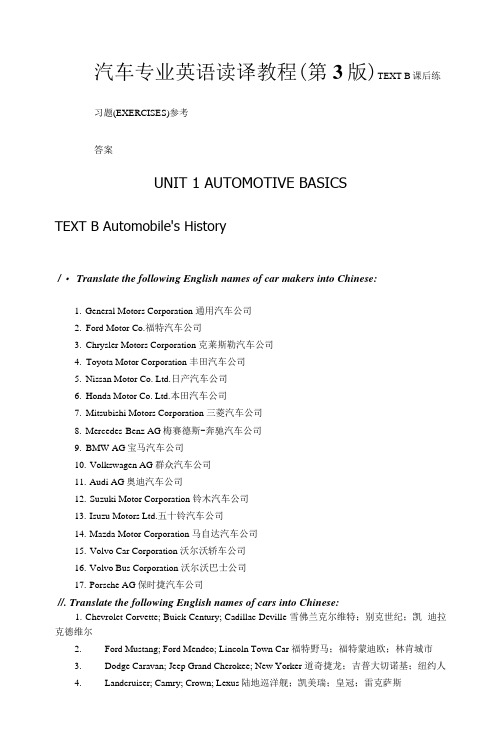
汽车专业英语读译教程(第3版)TEXT B课后练习题(EXERCISES)参考答案UNIT 1 AUTOMOTIVE BASICSTEXT B Automobile's History/ ・ Translate the following English names of car makers into Chinese:1.General Motors Corporation 通用汽车公司2.Ford Motor Co.福特汽车公司3.Chrysler Motors Corporation 克莱斯勒汽车公司4.Toyota Motor Corporation 丰田汽车公司5.Nissan Motor Co. Ltd.日产汽车公司6.Honda Motor Co. Ltd.本田汽车公司7.Mitsubishi Motors Corporation 三菱汽车公司8.Mercedes-Benz AG梅赛德斯-奔驰汽车公司9.BMW AG宝马汽车公司10.Volkswagen AG群众汽车公司11.Audi AG奥迪汽车公司12.Suzuki Motor Corporation 铃木汽车公司13.Isuzu Motors Ltd.五十铃汽车公司14.Mazda Motor Corporation 马自达汽车公司15.Volvo Car Corporation 沃尔沃轿车公司16.Volvo Bus Corporation 沃尔沃巴士公司17.Porsche AG保时捷汽车公司//. Translate the following English names of cars into Chinese:1.Chevrolet Corvette; Buick Century; Cadillac Deville 雪佛兰克尔维特;别克世纪;凯迪拉克德维尔2.Ford Mustang; Ford Mendeo; Lincoln Town Car 福特野马;福特蒙迪欧;林肯城市3.Dodge Caravan; Jeep Grand Cherokee; New Yorker 道奇捷龙;吉普大切诺基;纽约人ndcruiser; Camry; Crown; Lexus陆地巡洋舰;凯美瑞;皇冠;雷克萨斯1.What are the advantages of continuously variable transmission?Because there are no gears to tie a given road speed directly to a given engine speed, the CVT can vary the engine speed as needed to access maximum power as well as maximum fuel efficiency. This allows the CVT to provide quicker acceleration than a conventional automatic or manual transmission while delivering superior fuel economy.2.What are the main components of automated manual transmission?Transmission control ECU, clutch activator, transmission actuator, operators, and sensorsII. Translate the following paragraph into Chinese :The basic technical criteria for continuously variable transmissions are size, weight, transmission-ratio range, transfer efficiency, noise emissions and installation possibilities. With regard to these aspects, mechanical continuously variable transmissions, in the form of chain-driven transmission, have provided the best results so far.评判无级变速器的基本技术标准是尺寸、重量、传动比范围、传动效率、噪声排放和安装可能性。

汽车专业英文版Car Specialization in English VersionIntroductionThe automotive industry has witnessed significant growth and development globally. As a result, English language skills have become increasingly important for professionals in the car industry. This article aims to explore the significance of mastering automotive-specific English terminology and providing insights into the benefits it brings to professionals in the field.Mastering Automotive-Specific English Terminology1. Increased Efficiency in CommunicationProfessionals in the automotive industry who possess a strong command of automotive-specific English terminology can communicate more effectively within their field. This efficiency is crucial when communicating with colleagues, clients, and suppliers from different linguistic backgrounds. Clear and precise communication ensures smoother workflow, leading to better collaboration and understanding.2. Enhanced Global Networking OpportunitiesEnglish has emerged as the global language of business, including the automotive industry. Professionals who can effectively communicate in English have an advantage when it comes to networking and collaborating with global counterparts. By engaging in international conferences, seminars,and industry events, professionals can build strong connections with key industry players and expand their professional network across borders.3. Access to Updated Industry InformationThe automotive industry is dynamic and constantly evolving. Professionals who can read and understand English publications, research papers, and industry reports gain access to a vast amount of up-to-date information. English is widely used in international automotive journals and trade publications, providing valuable insights into the latest trends, technological advancements, and market dynamics. Staying knowledgeable about the industry's latest developments is essential for professionals to stay competitive.4. Expanded Opportunities for Career AdvancementFluency in automotive-specific English terminology opens up new career opportunities for professionals. Many multinational companies in the automotive sector require employees who can communicate effectively in English. Having proficiency in English gives professionals a competitive edge when applying for managerial or leadership positions, both domestically and internationally. It showcases their ability to navigate the global marketplace and work in diverse teams across borders.5. Ability to Understand and Utilize Technical DocumentationProfessionals in the automotive industry often need to study technical manuals, engineering specifications, and software documentation written in English. Mastering automotive-specific English allows professionals to understand and utilize these resources effectively. This ensures that they cananalyze technical information accurately, troubleshoot problems, and implement appropriate solutions. Such knowledge and skills are crucial for ensuring smooth operations and reducing downtime in the automotive industry.ConclusionIn conclusion, mastering automotive-specific English terminology proves to be highly beneficial for professionals in the automotive industry. Improved communication efficiency, enhanced networking opportunities, access to industry updates, expanded career prospects, and the ability to utilize technical documentation are all advantages that arise from fluency in English. As the automotive industry continues to evolve and expand on a global scale, the importance of English proficiency will only continue to grow. Professionals who invest in developing their English language skills will position themselves at the forefront of the industry, ultimately leading to personal and professional success.。
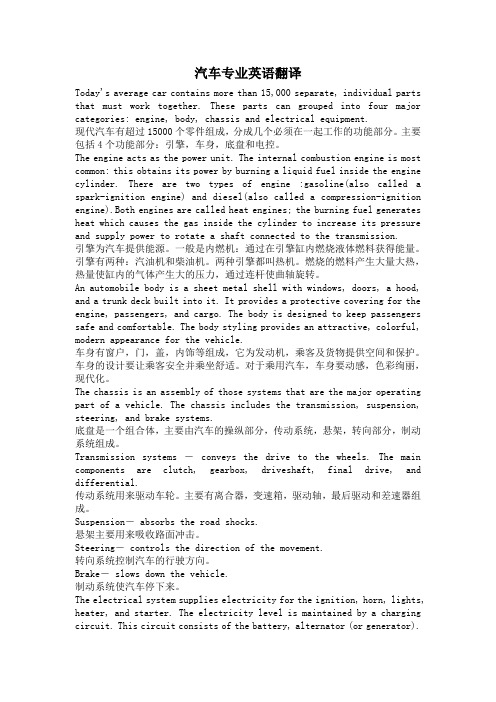
汽车专业英语翻译Today's average car contains more than 15,000 separate, individual parts that must work together. These parts can grouped into four major categories: engine, body, chassis and electrical equipment.现代汽车有超过15000个零件组成,分成几个必须在一起工作的功能部分。
主要包括4个功能部分:引擎,车身,底盘和电控。
The engine acts as the power unit. The internal combustion engine is most common: this obtains its power by burning a liquid fuel inside the engine cylinder. There are two types of engine :gasoline(also called a spark-ignition engine) and diesel(also called a compression-ignition engine).Both engines are called heat engines; the burning fuel generates heat which causes the gas inside the cylinder to increase its pressure and supply power to rotate a shaft connected to the transmission.引擎为汽车提供能源。
一般是内燃机:通过在引擎缸内燃烧液体燃料获得能量。
引擎有两种:汽油机和柴油机。
两种引擎都叫热机。

汽车工程专业英语全文翻译一当今的汽车一般都由15000 多个分散、独立且相互配合的零部件组成。
这些零部件主要分为四类:车身、发动机、底盘和电气设备。
Body:车身Engine:发动机Brakes:制动器Power train :传动系Steering:转向系Electrical:电器及电子设备Suspension:悬架Layout of a passenger car:乘用车总布置Layout of a commercial vehicle :商用车总布置1.1 车身汽车车身是由车窗、车门、发动机罩和行李箱盖焊接在金属板外壳发动机发动机作为动力装置。
最常见的发动机气缸的排列方式称为发动机配置。
直列式发动机的汽缸呈一列布置。
这个设计创造了一个简单的发动机缸体铸造。
在车辆应用中,汽缸数一般是2-6 缸,汽缸中心线与水平面垂直。
当汽缸数增多时,发动机尺寸和曲轴就成为一个问题。
解决这个问题的办法就是采用V 形(汽缸呈两列布置,且两列气缸之间夹角为V 形)发动机。
这个设计使发动机尺寸和曲轴都变得更短且更坚硬。
前置发动机纵向安装,既可前轮驱动也可后轮驱动。
后置发动机是将发动机安装在后轮后面。
发动机可横置或纵置,一般情况下为后轮驱动。
1.4 电气系统电气系统为起动机、点火系统、照明灯具、取暖器提供电能。
该电平由一个充电电路维护。
1.4.1 充电充电系统为所有汽车电子元件提供电能。
充电系统主要包括:蓄电池,交流发电机,电压调节器,即通常是交流发电机上不可或缺的,充电警告或指示灯和金属丝连成一个完整电路。
蓄电池为起动提供电能 ,然后发动机工作,交流发电机就为所有的电子元件提供电能。
同时也给蓄电池充电即用来使发动机起动。
电压调节器有过充保护作用。
1.4.2 起动起动系统包括:蓄电池、电缆、起动机、飞轮和换向器。
起动时,有两个动作同时运行,该起动机齿轮与飞轮齿圈啮合,并起动电机,然后运行传输到发动机曲轴。
起动机电机将起动机安装在发动机缸体上并由电池供电。
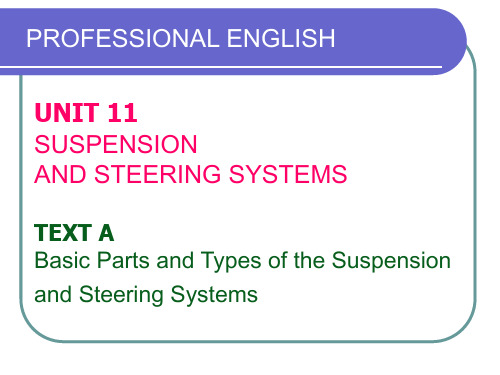
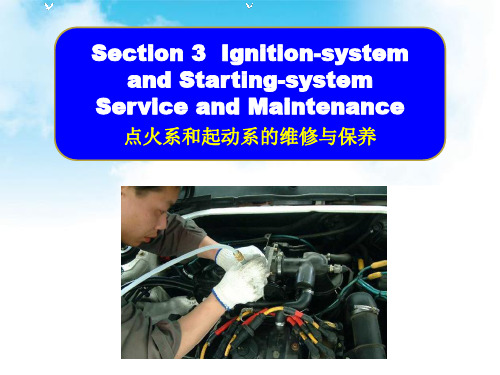
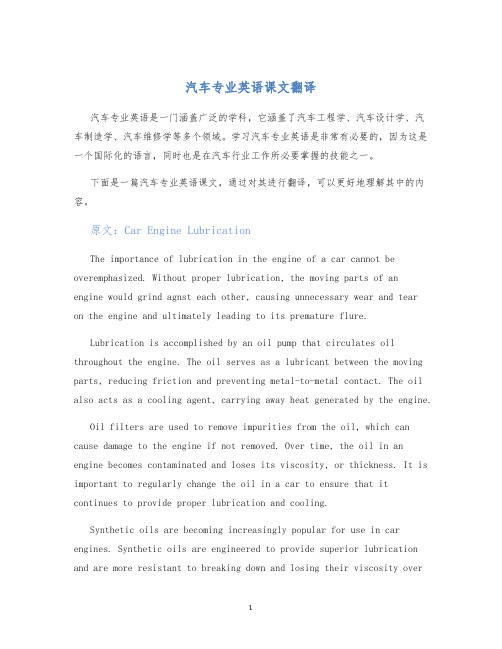
汽车专业英语课文翻译汽车专业英语是一门涵盖广泛的学科,它涵盖了汽车工程学、汽车设计学、汽车制造学、汽车维修学等多个领域。
学习汽车专业英语是非常有必要的,因为这是一个国际化的语言,同时也是在汽车行业工作所必要掌握的技能之一。
下面是一篇汽车专业英语课文,通过对其进行翻译,可以更好地理解其中的内容。
原文:Car Engine LubricationThe importance of lubrication in the engine of a car cannot be overemphasized. Without proper lubrication, the moving parts of anengine would grind agnst each other, causing unnecessary wear and tearon the engine and ultimately leading to its premature flure.Lubrication is accomplished by an oil pump that circulates oil throughout the engine. The oil serves as a lubricant between the moving parts, reducing friction and preventing metal-to-metal contact. The oil also acts as a cooling agent, carrying away heat generated by the engine.Oil filters are used to remove impurities from the oil, which can cause damage to the engine if not removed. Over time, the oil in an engine becomes contaminated and loses its viscosity, or thickness. It is important to regularly change the oil in a car to ensure that it continues to provide proper lubrication and cooling.Synthetic oils are becoming increasingly popular for use in car engines. Synthetic oils are engineered to provide superior lubrication and are more resistant to breaking down and losing their viscosity overtime. They also provide better protection agnst wear and tear and can improve fuel efficiency.Overall, proper lubrication is essential for the longevity and performance of a car engine. Regularly changing the oil and using high-quality synthetic oils can help to ensure that a car engine remns in top condition.译文:汽车发动机润滑汽车发动机的润滑问题不可忽视。

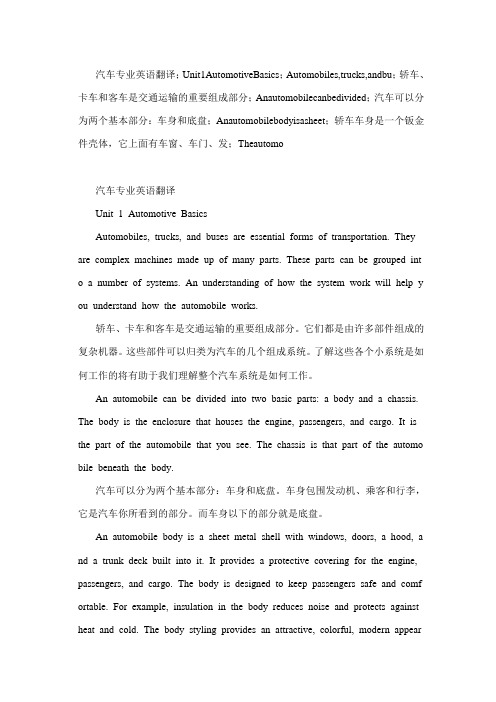
汽车专业英语翻译;Unit1AutomotiveBasics;Automobiles,trucks,andbu;轿车、卡车和客车是交通运输的重要组成部分;Anautomobilecanbedivided;汽车可以分为两个基本部分:车身和底盘;Anautomobilebodyisasheet;轿车车身是一个钣金件壳体,它上面有车窗、车门、发;Theautomo汽车专业英语翻译Unit 1 Automotive BasicsAutomobiles, trucks, and buses are essential forms of transportation. They are complex machines made up of many parts. These parts can be grouped int o a number of systems. An understanding of how the system work will help y ou understand how the automobile works.轿车、卡车和客车是交通运输的重要组成部分。
它们都是由许多部件组成的复杂机器。
这些部件可以归类为汽车的几个组成系统。
了解这些各个小系统是如何工作的将有助于我们理解整个汽车系统是如何工作。
An automobile can be divided into two basic parts: a body and a chassis. The body is the enclosure that houses the engine, passengers, and cargo. It is the part of the automobile that you see. The chassis is that part of the automo bile beneath the body.汽车可以分为两个基本部分:车身和底盘。
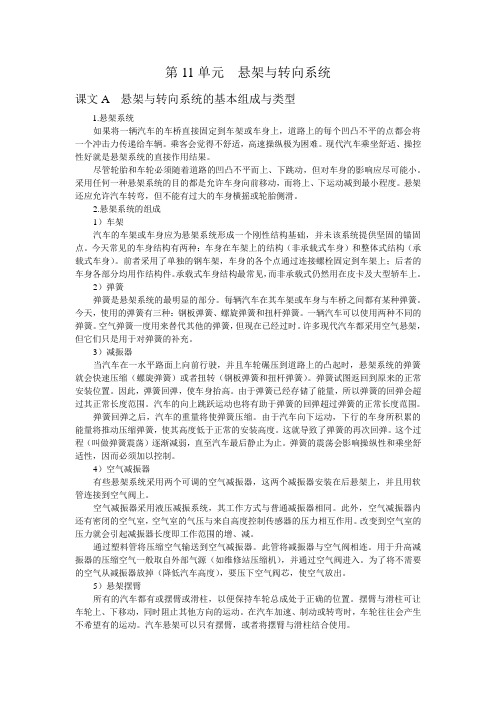
第11单元悬架与转向系统课文A 悬架与转向系统的基本组成与类型1.悬架系统如果将一辆汽车的车桥直接固定到车架或车身上,道路上的每个凹凸不平的点都会将一个冲击力传递给车辆。
乘客会觉得不舒适,高速操纵极为困难。
现代汽车乘坐舒适、操控性好就是悬架系统的直接作用结果。
尽管轮胎和车轮必须随着道路的凹凸不平而上、下跳动,但对车身的影响应尽可能小。
采用任何一种悬架系统的目的都是允许车身向前移动,而将上、下运动减到最小程度。
悬架还应允许汽车转弯,但不能有过大的车身横摇或轮胎侧滑。
2.悬架系统的组成1)车架汽车的车架或车身应为悬架系统形成一个刚性结构基础,并未该系统提供坚固的锚固点。
今天常见的车身结构有两种:车身在车架上的结构(非承载式车身)和整体式结构(承载式车身)。
前者采用了单独的钢车架,车身的各个点通过连接螺栓固定到车架上;后者的车身各部分均用作结构件。
承载式车身结构最常见,而非承载式仍然用在皮卡及大型轿车上。
2)弹簧弹簧是悬架系统的最明显的部分。
每辆汽车在其车架或车身与车桥之间都有某种弹簧。
今天,使用的弹簧有三种:钢板弹簧、螺旋弹簧和扭杆弹簧。
一辆汽车可以使用两种不同的弹簧。
空气弹簧一度用来替代其他的弹簧,但现在已经过时。
许多现代汽车都采用空气悬架,但它们只是用于对弹簧的补充。
3)减振器当汽车在一水平路面上向前行驶,并且车轮碾压到道路上的凸起时,悬架系统的弹簧就会快速压缩(螺旋弹簧)或者扭转(钢板弹簧和扭杆弹簧)。
弹簧试图返回到原来的正常安装位置。
因此,弹簧回弹,使车身抬高。
由于弹簧已经存储了能量,所以弹簧的回弹会超过其正常长度范围。
汽车的向上跳跃运动也将有助于弹簧的回弹超过弹簧的正常长度范围。
弹簧回弹之后,汽车的重量将使弹簧压缩。
由于汽车向下运动,下行的车身所积累的能量将推动压缩弹簧,使其高度低于正常的安装高度。
这就导致了弹簧的再次回弹。
这个过程(叫做弹簧震荡)逐渐减弱,直至汽车最后静止为止。
弹簧的震荡会影响操纵性和乘坐舒适性,因而必须加以控制。


汽车专业英语精品课件在汽车行业工作的人士,需要掌握一定数量的专业英语词汇和表达方式。
下面是一份精品课件,帮助你学习汽车专业英语。
一、汽车基础知识1. Engine(发动机): The heart of the vehicle that converts fuel into mechanical energy.2. Transmission(变速箱): A system that transfers power from the engine to the wheels.3. Suspension(悬架): System of springs, shock absorbers, and linkages that connects a vehicle to its wheels.4. Chassis(底盘): The internal framework of a vehicle which supports the body and other components.二、汽车零部件1. Brake pads(制动片): Friction materials used to stop a vehicle by applying pressure to the brake rotors.2. Radiator(散热器): A device that cools the engine by transferring heat away from the coolant.3. Fuel pump(燃油泵): Component that pumps fuel from the tank to the engine.4. Alternator(发电机): Device that generates power to recharge the battery and supply electrical components.三、汽车维修与保养1. Oil change(换油): Process of draining old engine oil and replacing it with fresh oil.2. Tire rotation(轮胎换位): Moving tires to different positions on a vehicle to ensure even wear.3. Spark plug replacement(火花塞更换): Installing new spark plugs to maintain engine performance.4. Coolant flush(冷却液更换): Removing old coolant and replacing it to prevent overheating.四、购买汽车常用术语1. MSRP(Manufacturer's Suggested Retail Price): The price recommended by the manufacturer for a vehicle.2. Down payment(首付): Initial payment made when purchasing a vehicle to reduce the loan amount.3. APR(Annual Percentage Rate): The interest rate on a loan over a year.4. Trade-in value(以旧换新价值): The amount credited for a vehicle when trading it in for a new one.五、汽车行业发展趋势1. Electric vehicles(电动汽车): Cars powered by electricity rather than traditional fuels.2. Autonomous driving(自动驾驶): Vehicles equipped with technology to navigate without human input.3. Connected cars(互联汽车): Vehicles with internet connectivity to enhance safety and convenience.4. Mobility as a Service (MaaS)(出行服务): Providing transportation solutions through apps and platforms.通过学习这些汽车专业英语,你将更好地了解汽车行业以及相关知识。